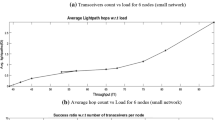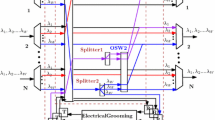Abstract
This paper studies a traffic grooming in wavelength-division multiplexing (WDM) mesh networks for the SONET/SDH streams requested between node pairs. The traffic could be groomed at the access node before converting to an optical signal carried in the all-optical network. We design a virtual topology with a given physical topology to satisfy multiple objectives and constraints. The grooming problem of a static demand is considered as an optimization problem. The traditional algorithms found in the literatures mostly focus on a single objective either to maximize the performance or to minimize the cost. We propose a multi-objective evolutionary algorithm to solve a grooming problem that optimizes multiple objectives all together at the same time. In this paper we consider the optimization of three objectives: maximize the traffic throughput, minimize the number of transceivers, and minimize the average propagation delay or average hop counts. The simulation results show that our approach is superior to an existing heuristic approaches in an acceptable running time.
Similar content being viewed by others
Explore related subjects
Discover the latest articles, news and stories from top researchers in related subjects.References
J.L. Cohon, Multiobjective Programming and Planning (Academic Press, New York, 1978).
K. Deb, Multi-Objective Optimization Using Evolutionary Algorithms (Wiley, New York, 2001).
C.M. Fonseca and P.J. Fleming, Genetic algorithms for multiobjective optimization: Formulation, discussion and generaliation, in: Proc. of the 5th Internat. Conf. on Genetic Algorithms (1993) pp. 416–423.
J. Horn, N. Nafpliotis and D.E. Goldberg, A niched Pareto genetic algorithm for multi-objective optimization, in: Proc. of the 1st IEEE Conf. on Evolutionary Computation, Vol. 1 (1994) pp. 82–87.
V.R. Konda and T.Y. Chow, Algorithm for traffic grooming in optical networks to minimize the number of transceivers, in: IEEE 2001 High Performance Switching and Routing Workshop (2001) pp. 218–221.
J. Koski, Multicriterion Optimization in Structural Design, New Directions in Optimum Structural Design (Wiley, New York, 1984) pp. 483–503.
J.D. Schaffer, Multiple objective optimization with vector evaluated genetic algorithms, in genetic algorithms and their application, in: Proc. of the 1st Internat. Conf. on Genetic Algorithms (Lawrence Erlbaum, 1985) pp. 93–100.
N. Srinavas and K. Deb, Multiobjective optimization using nondominated sorting in genetic algorithms, Evolutionary Computation 2(3) (1994) 221–248.
R.E. Steuer, Multiple Criteria Optimization: Theory, Comutation and Application (Wiley, New York, 1986).
S. Thiagarajan and A.K. Somani, A capacity correlation model for WDM networks with constrained grooming capabilities, in: IEEE Internat. Conf. on Communications, Vol. 5 (2001) pp. 1592–1596.
S. Thiagarajan and A.K. Somani, Capacity fairness of WDM networks with grooming capabilities, Optical Networks Magazine 2(3) (2001) 24–31.
K. Zhu and B. Mukherjee, Traffic grooming in an optical WDM mesh network, IEEE Journal on Selected Areas in Communications 20(1) (2002) 122–133.
E. Zitzler and L. Thiele, Multi-objective evolutionary algorithms: A comparative case study and the strength Pareto approach, IEEE Transactions on Evolutionary Computation 3(4) (1999) 257–271.
Author information
Authors and Affiliations
Corresponding author
Rights and permissions
About this article
Cite this article
Prathombutr, P., Stach, J. & Park, E.K. An Algorithm for Traffic Grooming in WDM Optical Mesh Networks with Multiple Objectives. Telecommun Syst 28, 369–386 (2005). https://doi.org/10.1007/s11235-004-5578-8
Issue Date:
DOI: https://doi.org/10.1007/s11235-004-5578-8




